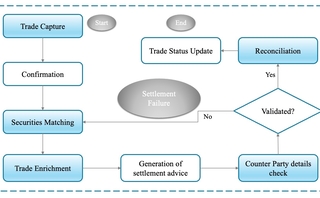Waters Wrap: Blockchain—let’s put the hammer back in the box
With the ASX Chess DLT failure and users ignoring DTCC’s DLT option for its Trade Information Warehouse, Anthony wonders what it will take for the industry to stop touting this buzzword for non-specialized needs.

Before I start ripping blockchain—the term I’ll use interchangeably with distributed ledger technology (“Anthony! You’re showing your ignorance!”)—let’s establish some ground rules.
First, if we are talking about cryptocurrencies, digital assets, asset tokenization—all that good “fake money” stuff—blockchain and its miscreant friends can be the right tools for the job. The experts I speak to are at least 50/50 on that assertion. I’ll throw payments in there, too, because that’s not what we cover here at WatersTechnology, and I don’t know enough about it. So I’ll allow it. And while many have lost fortunes due to crypto hacks or crypto exchange/vault/whatever failures, the digital currency isn’t going anywhere, even though I wish very much that it would. And security tokenization and certain forms of digital assets can be viewed—let me buttress myself—as tangible points of advancement in the world of finance. Finally, for this column, we’re talking exclusively about the wholesale capital markets; I know nothing about blockchain’s utility in other industries and do not care to learn.
Let’s also remove the calamity that is FTX. Or Celsius. Or Genesis. Or … the list goes on. Let’s ignore that Symbiont—which was going to “revolutionize Wall Street” went belly up. And we’ll forget about the hype train that hit full speed from 2015 to 2018, then subsequently derailed. And we’ll cover our ears and eyes regarding quantum computing making blockchain security impotent.
With all of those caveats established, we can discuss the idea that distributed ledger technology could one day revolutionize the infrastructure that runs more traditional asset classes like equities, foreign exchange and fixed income.
At the height of blockchain’s irrational exuberance, two major capital markets projects generated the most attention—the Australian Securities Exchange’s (ASX’s) decision to replace its equities clearing and settlement platform, Chess, using DLT; and the Depository Trust and Clearing Corp. (DTCC) in part using DLT to re-platform its Trade Information Warehouse (TIW), an electronic database of cleared and bilateral credit default swap records. The ASX plan started back in 2015; the DTCC’s project followed the next year.
Last year, ASX’s Chess blockchain experiment failed. And while the DTCC’s TIW DLT is alive, as we first reported, it’s like Tom Hanks in Castaway—alone on an island.
The DTCC has been a flagbearer—perhaps even a pallbearer—for blockchain since those halcyon days when everyone lost their minds upon learning that Blythe Masters left JPMorgan to head Digital Asset. And here’s something that might surprise you, considering how much I enjoy shitting on blockchain: I believe the industry utility absolutely should have been on the bleeding edge of DLT experimentation. The DTCC is about back-office functions, clearing and settlement. The promise of blockchain offered two distinct things: the hope of automation in the massively manual manure pile that is the back-office, and, perhaps more importantly, loosening the purse strings for chronically underfunded back-office projects.
If ever there was an organization in the capital markets that should have been early-in on DLT, it was the DTCC. And (as best as I can tell) it hasn’t failed, thus far, in its objectives. Project Ion, a pilot to leverage DLT for settlement, is progressing (but has not yet proven a better option than current technologies) and the TIW DLT is available … even if no one (currently!) wants it.
The re-platformed TIW works thusly: “It has been delivered [in October 2022] on cloud technology, with support for DLT capabilities at the access layer, which clients would be able to leverage at their discretion.” This is what Chris Childs, a senior executive at DTCC, told Wei-Shen Wong when she broke the story that zero (0) users have chosen to access the platform via the DLT option. But the DTCC’s roughly 4,000 clients (representing approximately 69,000 accounts) are live on the cloud. So that’s Cloud: 4,000 and Blockchain: 0, if you’re keeping score at home.
According to our sources, the DLT access layer works, but users voted and pulled the lever for cloud being the path forward. While the TIW rollout was delayed several times (the original go-live was marked for late 2018), ambitious projects take time and as long as the result is a success, all will be forgiven.
The takeaway here is that rather than forcing one option down everyone’s throats, the DTCC made a conscious effort to embrace both cloud and blockchain, and let users decide which works best for their needs.
The haves and have-nots
Then there’s the ASX.
To be frank, the ASX Chess DLT project was an embarrassing failure. It cost the exchange and market participants a lot of money, and it cost a fair number of people their jobs.
From the jump, industry participants expressed concern/doubt/exasperation about using a nascent technology to replace a functioning legacy technology. Delays mounted. ASX tried gimmicks to get users to work with DLT. Then, mercifully, the exchange pulled the plug on the project and has fallen back to reassess what went wrong and where to go next. This past February, Helen Lofthouse, managing director and CEO at ASX, had this to say:
In my mind, what separates DTCC and ASX is the DTCC did deliver (as best we can tell), even if late, but the industry decided that the time was not nigh for DLT
“We’re aware that there is no off-the-shelf vendor solution that can meet all the requirements of the Australian market … so we will need to conduct a detailed assessment of vendor solutions to understand the customization and integration requirements. This will take time and it will also be dependent on vendors’ availability to carry out this assessment work. You can expect our next progress update to be at our strategy day in June. … This is a once-in-a-generation reset of this technology and it’s important that we get it right.” (“Once in a generation,” of course, including the ability to completely restart the reset.)
It’s worth noting that in October, ASX named Google Cloud “as its preferred cloud partner to build its data product innovation strategy.” Chess wasn’t mentioned specifically, but the release stated this: “The exchange is in the process of renewing several core platforms which will see the average age of the core equity market technologies drop from over 20 years to an average of less than five years.” The Chess/DLT reset announcement came after. And, of course, Google, AWS and Microsoft have been snapping up major exchanges to put their trading infrastructures in the cloud.
In my mind, what separates DTCC and ASX is the DTCC did deliver on its promise, albeit late, but the industry decided that the time was not nigh for DLT. On the other hand, my opinion based on many conversations with industry experts is that ASX wanted to appear to be cutting-edge on a global scale and hitched its wagon to blockchain. Unfortunately for them, the latch snapped.
‘What went wrong’
Let’s take a step back for a moment.
At the end of March, consultancy Opimas put out a report titled, “Decentralized Finance and Fixed Income—What Went Wrong.” It notes that DeFi bonds, which are bonds processed using DLT, “account for less than 0.001% of the amount outstanding in global fixed income markets, and even less in terms of trading volume. In total, [over the last six years, Opimas] identified only about 30 issuances of DeFi bonds, and many of these were pilots. However, in 2023 so far, there has been an increase in activity (five through February).” The report also notes that all of those DeFi bond issuances mentioned previously were issued outside of the US.
The paper does an excellent job of laying out why there was/is such promise around DeFi bonds. It delves into individual issuances; and it explains why and where it all “went wrong,” but also what might lie ahead. Part of the reason for the barely noticeable uptake, though, is the underpinning technology, itself.
First, it states that shady practices exist where “actual transactions are recorded in a traditional system with a copy of those transactions posted to a public blockchain, such as Ethereum.” A true DLT-based transaction, this is not. Additionally, some bonds appear to have been pre-arranged transactions, and thus do not represent “natural liquidity.”
Perhaps more damning to the use of DLT, itself: “Too often, the DLT portion of the DeFi bond is extremely limited and covers little more than the bond registrar functions—that is, summing purchases and subtracting sales to determine net positions. This is not hard to do technically. At the same time, most trading or related payment activity takes place outside of the blockchain.”
I’d love to quote so much more, but, again, the paper is worth a read. (There’s a very enlightening piece, too, about the risk posed by DLT, using specific warnings to investors about tech risk from the likes of Societe Generale and European Investment Bank (EIB) for their products.)
“The unfortunate Silicon Valley disease of innovation via press release and a fake-it-’til-you-make-it approach will not impress bond investors. Indeed, it is more likely to drive them away,” the report states. Just to balance things out, though, in case you think the report is simply a DLT hit piece—it is not. While there are theoretical advantages to DLT, the hype outpaces the benefits—at this point, anyway. “DLT does have the advantage that it has crystalized a lot of market participants’ thinking in terms of technology. It also has considerable momentum behind it and, therefore, lends itself well to addressing the bond market’s inefficiencies.”
Hype machine
Finally, some recent headlines:
From Bloomberg News (February 28, 2023): “Goldman’s Digital-Asset Team Open to Hiring as it Rolls Out Blockchain Platform”
From The Wall Street Journal (February 28, 2023): “The Next Frontier for Bonds: Blockchain?”
From The Banker (April 6, 2023): “DLT Pilots Still in Favour for Global Digital Finance”
From The Wall Street Journal (February 13, 2023): “AI Becomes Silicon Valley’s Next Buzzy Bandwagon as Crypto Boom Fizzles”
Now, make no mistake; there are dozens of articles on WatersTechnology that tout a DLT-based project or explore how DLT can be used to fix post-trade processes. As the editor, I gave the green light to all of them. Hell, our podcast, which I helped start back in January 2016, has much of that. I have this Waters Wrap about Digital Asset (the company, not the concept) and even one of my all-time favorite columns tries to understand the value of DLT in the capital markets.
Technology reporters sometimes try to highlight cool new tools, trends or ways of thinking; sometimes we’re critical of legacy vendors, platforms, and ideas. It is so easy to get carried away in a wave of hype. I hope we do this well. We sometimes fail.
What has become clear to me, though, is that while R&D investment dollars have been funneled into blockchain, the ROI has not materialized when it comes to replacing traditional tech for traditional asset classes. At the same time, the world of finance is increasingly moving to the cloud. And to take it a step further: Cloud more easily connects into other new (or more “newly used”) technologies, namely machine learning and natural language processing, open-source tools, APIs, and interoperability. And, again, we haven’t scratched the surface of quantum computing. Nor have we even talked about the over-used term “low-code/no-code development,” or, for that matter, the advent of large language models, an area of tech evolution that is both revolutionary and ripe for PR exploitation.
Tech development these days is all about providing better/easier context around a rising sea of data.
“Technology” and “hype” go hand in hand. I’ve learned this in my 13-plus years covering financial technology and seeing first-hand the advent of blockchain/DLT. I’ve written many columns about my skepticism of blockchain/DLT. With the above diatribe, I hope that I’ve provided some context as to why I don’t care to write about this topic for a while. The two biggest projects that weren’t related to tokenization and whatnot failed or were essentially ignored. I will focus on the day-to-day challenges that technologists and data professionals in the capital markets face.
With all of that said, if you think I’m an idiot, please do let me know: anthony.malakian@infopro-digital.com.
The image accompanying this column is “The Alling Children” by Oliver Tarbell Eddy, courtesy of The Met’s open-access program.
Only users who have a paid subscription or are part of a corporate subscription are able to print or copy content.
To access these options, along with all other subscription benefits, please contact info@waterstechnology.com or view our subscription options here: http://subscriptions.waterstechnology.com/subscribe
You are currently unable to print this content. Please contact info@waterstechnology.com to find out more.
You are currently unable to copy this content. Please contact info@waterstechnology.com to find out more.
Copyright Infopro Digital Limited. All rights reserved.
You may share this content using our article tools. Printing this content is for the sole use of the Authorised User (named subscriber), as outlined in our terms and conditions - https://www.infopro-insight.com/terms-conditions/insight-subscriptions/
If you would like to purchase additional rights please email info@waterstechnology.com
Copyright Infopro Digital Limited. All rights reserved.
You may share this content using our article tools. Copying this content is for the sole use of the Authorised User (named subscriber), as outlined in our terms and conditions - https://www.infopro-insight.com/terms-conditions/insight-subscriptions/
If you would like to purchase additional rights please email info@waterstechnology.com
More on Emerging Technologies
Quants look to language models to predict market impact
Oxford-Man Institute says LLM-type engine that ‘reads’ order-book messages could help improve execution
The IMD Wrap: Talkin’ ’bout my generation
As a Gen-Xer, Max tells GenAI to get off his lawn—after it's mowed it, watered it and trimmed the shrubs so he can sit back and enjoy it.
This Week: Delta Capita/SSimple, BNY Mellon, DTCC, Broadridge, and more
A summary of the latest financial technology news.
Waters Wavelength Podcast: The issue with corporate actions
Yogita Mehta from SIX joins to discuss the biggest challenges firms face when dealing with corporate actions.
JP Morgan pulls plug on deep learning model for FX algos
The bank has turned to less complex models that are easier to explain to clients.
LSEG-Microsoft products on track for 2024 release
The exchange’s to-do list includes embedding its data, analytics, and workflows in the Microsoft Teams and productivity suite.
Data catalog competition heats up as spending cools
Data catalogs represent a big step toward a shopping experience in the style of Amazon.com or iTunes for market data management and procurement. Here, we take a look at the key players in this space, old and new.
Harnessing generative AI to address security settlement challenges
A new paper from IBM researchers explores settlement challenges and looks at how generative AI can, among other things, identify the underlying cause of an issue and rectify the errors.








